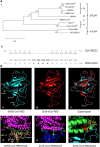A review on the cleavage priming of the spike protein on coronavirus by angiotensin-converting enzyme-2 and furin
- PMID: 32274964
- PMCID: PMC7189411
- DOI: 10.1080/07391102.2020.1754293
A review on the cleavage priming of the spike protein on coronavirus by angiotensin-converting enzyme-2 and furin
Abstract
The widespread antigenic changes lead to the emergence of a new type of coronavirus (CoV) called as severe acute respiratory syndrome (SARS)-CoV-2 that is immunologically different from the previous circulating species. Angiotensin-converting enzyme-2 (ACE-2) is one of the most important receptors on the cell membrane of the host cells (HCs) which its interaction with spike protein (SP) with a furin-cleavage site results in the SARS-CoV-2 invasion. Hence, in this review, we presented an overview on the interaction of ACE-2 and furin with SP. As several kinds of CoVs, from various genera, have at their S1/S2 binding site a preserved site, we further surveyed the role of furin cleavage site (FCS) on the life cycle of the CoV. Furthermore, we discussed that the small molecular inhibitors can limit the interaction of ACE-2 and furin with SP and can be used as potential therapeutic platforms to combat the spreading CoV epidemic. Finally, some ongoing challenges and future prospects for the development of potential drugs to promote targeting specific activities of the CoV were reviewed. In conclusion, this review may pave the way for providing useful information about different compounds involved in improving the effectiveness of CoV vaccine or drugs with minimum toxicity against human health.Communicated by Ramaswamy H. Sarma.
Keywords: Coronavirus; angiotensin-converting enzyme-2; enzyme inhibition; furin; spike protein.
Figures




Similar articles
- Distinctive Roles of Furin and TMPRSS2 in SARS-CoV-2 Infectivity.J Virol. 2022 Apr 27;96(8):e0012822. doi: 10.1128/jvi.00128-22. Epub 2022 Mar 28.J Virol. 2022.PMID: 35343766Free PMC article.
- Genome-wide bioinformatics analysis of human protease capacity for proteolytic cleavage of the SARS-CoV-2 spike glycoprotein.Microbiol Spectr. 2024 Feb 6;12(2):e0353023. doi: 10.1128/spectrum.03530-23. Epub 2024 Jan 8.Microbiol Spectr. 2024.PMID: 38189333Free PMC article.
- SARS-CoV-2 Spike Furin Cleavage Site and S2' Basic Residues Modulate the Entry Process in a Host Cell-Dependent Manner.J Virol. 2022 Jul 13;96(13):e0047422. doi: 10.1128/jvi.00474-22. Epub 2022 Jun 9.J Virol. 2022.PMID: 35678602Free PMC article.
- Variable Clinical Manifestations of COVID-19: Viral and Human Genomes Talk.Iran J Allergy Asthma Immunol. 2020 Oct 18;19(5):456-470. doi: 10.18502/ijaai.v19i5.4461.Iran J Allergy Asthma Immunol. 2020.PMID: 33463113Review.
- The Emergence of the Spike Furin Cleavage Site in SARS-CoV-2.Mol Biol Evol. 2022 Jan 7;39(1):msab327. doi: 10.1093/molbev/msab327.Mol Biol Evol. 2022.PMID: 34788836Free PMC article.Review.
Cited by
- Genomics insights of SARS-CoV-2 (COVID-19) into target-based drug discovery.Med Chem Res. 2020;29(10):1777-1791. doi: 10.1007/s00044-020-02610-8. Epub 2020 Jul 31.Med Chem Res. 2020.PMID: 32837137Free PMC article.Review.
- Drugs targeting various stages of the SARS-CoV-2 life cycle: Exploring promising drugs for the treatment of Covid-19.Cell Signal. 2020 Oct;74:109721. doi: 10.1016/j.cellsig.2020.109721. Epub 2020 Jul 22.Cell Signal. 2020.PMID: 32711111Free PMC article.Review.
- Remdesivir (GS-5734) as a therapeutic option of 2019-nCOV main protease - in silico approach.J Biomol Struct Dyn. 2021 Aug;39(13):4701-4714. doi: 10.1080/07391102.2020.1781694. Epub 2020 Jun 22.J Biomol Struct Dyn. 2021.PMID: 32568620Free PMC article.
- Virtual screening, ADMET prediction and dynamics simulation of potential compounds targeting the main protease of SARS-CoV-2.J Biomol Struct Dyn. 2021 Oct;39(17):6617-6632. doi: 10.1080/07391102.2020.1796812. Epub 2020 Jul 25.J Biomol Struct Dyn. 2021.PMID: 32715956Free PMC article.
- Scaffold morphing of arbidol (umifenovir) in search of multi-targeting therapy halting the interaction of SARS-CoV-2 with ACE2 and other proteases involved in COVID-19.Virus Res. 2020 Nov;289:198146. doi: 10.1016/j.virusres.2020.198146. Epub 2020 Aug 29.Virus Res. 2020.PMID: 32866534Free PMC article.
References
- Amer H., Alqahtani A. S., Alaklobi F., Altayeb J., & Memish Z. A. (2018). Healthcare worker exposure to Middle East respiratory syndrome coronavirus (MERS-CoV): Revision of screening strategies urgently needed. International Journal of Infectious Diseases, 71, 113–116. 10.1016/j.ijid.2018.04.001 - DOI - PMC - PubMed
Publication types
MeSH terms
Substances
LinkOut - more resources
Full Text Sources
Other Literature Sources
Medical
Research Materials
Miscellaneous
